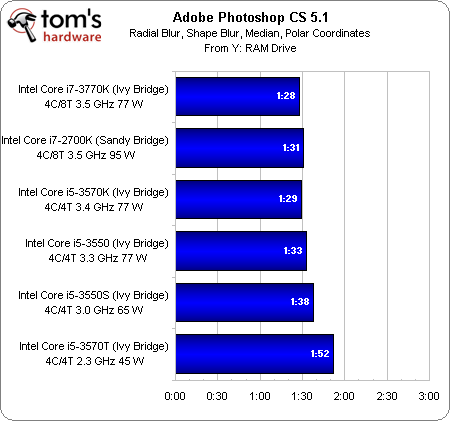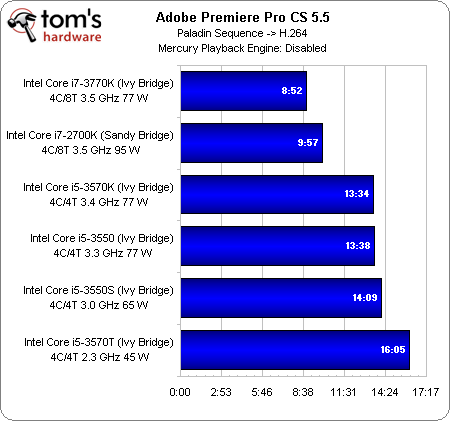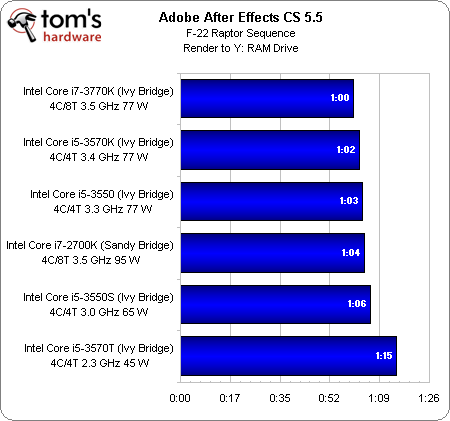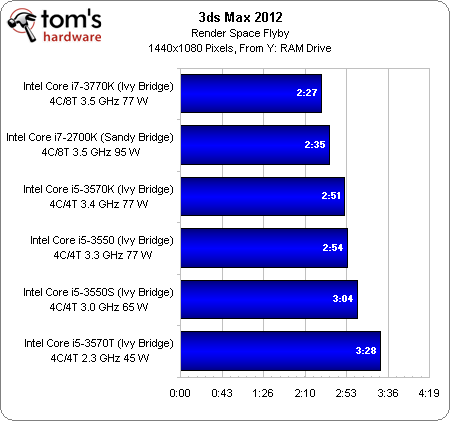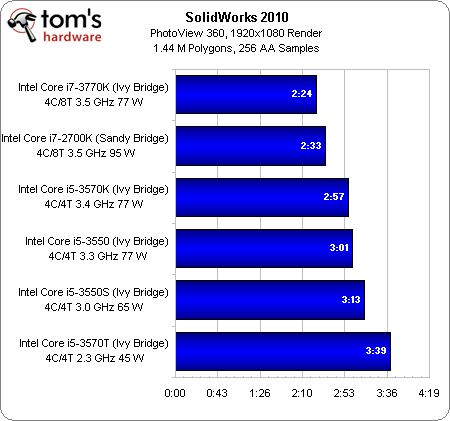Core i5-3570K, -3550, -3550S, And -3570T: Ivy Bridge Efficiency
After recommending Sandy Bridge last year, we weren't particularly impressed by the new Ivy Bridge-based Core i7-3770K as an upgrade. But are Intel's more mainstream third-gen Core i5 processors any more attractive? We grab four models to find out.
Benchmark Results: Adobe CS 5.5 And Content Creation
All of the 95 W and 77W CPUs perform fairly similarly in Photoshop. The only drop-offs happen at 65 W and 45 W, where lower thermal ceilings keep Turbo Boost from doing as much for performance, since our test is fully-threaded.
Hyper-Threading and cache play much more of a role in Premiere Pro, where the two Core i7s get their work done in less than 10 minutes. Three of the Core i5s appear to serve up similar performance, while the 45 W model’s restrictive TDP again keeps that chip from accelerating as fast as it’d need to in order to keep up.
Remember that we’re using integrated graphics, so Adobe’s Mercury Playback Engine isn’t enjoying hardware acceleration. Finally, with CS 6, we’ll see OpenCL support start speeding up certain models from AMD, too.
Our After Effects test doesn’t really do a whole heck of a lot with Hyper-Threading, so the Core i7-2700K drops behind a couple of 77 W Core i5s, as Ivy Bridge’s architectural improvements play more of a role than the former flagship’s eight threads or larger cache.
Again, the only time performance really suffers is when the 45 W chip’s thermal envelope holds it back.
The two Core i7s rule in 3ds Max, which does utilize all of the cores we throw at it. The i5s lag back a little bit. And as you start putting the squeeze on TDP, the 65 W and 45 W Core i5s just can’t be pushed as hard.
Demonstrating similar behavior as 3ds Max, SolidWorks’ PhotoView 360 also exploits all eight of the Core i7’s threads, translating into a quantifiable performance advantage. The two 77 W i5s aren’t far behind, though. Only as you start limiting TDP does the workload take longer to finish.
Get Tom's Hardware's best news and in-depth reviews, straight to your inbox.
Current page: Benchmark Results: Adobe CS 5.5 And Content Creation
Prev Page Benchmark Results: SiSoft Sandra 2012 Next Page Benchmark Results: Productivity-
erraticfocus nice work in sorting out the facts and reminding us about the history and change from the lower power offerings in the intel stable..Reply
-
amdfangirl Does Intel allow underclocking and undervolting on H-series boards? If so, S and T series are pretty redundant.Reply -
Onikage 2700K looks a clear Winner to me ! got one last week from Microcenter at an ironic but sensational price 270$ !!!! hey 3770K try and beat that !Reply -
Outlander_04 In the real world gaming section you got a great big graph for the 3770k by adding a discreet graphics card . Why didn't you try a Llano system with an identical graphics card? Afraid the second tier AMD product would kick sand in intels face?Reply -
cangelini Outlander_04In the real world gaming section you got a great big graph for the 3770k by adding a discreet graphics card . Why didn't you try a Llano system with an identical graphics card? Afraid the second tier AMD product would kick sand in intels face?Because this is a story about the Intel chips. To the contrary, though, the AMD-based platform is more likely to bottleneck a discrete graphics card than the Intel one. AMD's strength is in the integrated graphics right now.Reply -
Outlander_04 The performance of a Llano chip is included in the article to compare its performance so it not just about intel cpu's . The intels were not as good in gaming in the integrated graphics so a graphics card was added so they'd look better there too . Its an unfair comparison and shows intel bias IMOReply -
jimmysmitty Outlander_04The performance of a Llano chip is included in the article to compare its performance so it not just about intel cpu's . The intels were not as good in gaming in the integrated graphics so a graphics card was added so they'd look better there too . Its an unfair comparison and shows intel bias IMOReply
Actually a lot of sites have shown just what Chris is talking about. Even a dual core Pentium with a HD6670 beats the top end Llano piece (a quad core) even with CFX of the IGP with a HD6570. Llano is great for some things but overall in DT its only a low end entry level product and is much weaker per core and per clock than Intels CPUs.
What Chris did was pulled the same charts from his first IB review and added in the HD2500 (the new low end Intel IGP) for comparison.
If someone cannot take this information and realize that its just for comparison and that its not to show anything better, then thats their problem. If this was a Llano article, or the Trinity article when it comes out, you better believe Chris will do everything to check ever performance aspect. But its not. Its an article to see if the T and S models are worth it.
Overll, llano is overrate in my book. We have barley sold any at my work place. Just doesn't have the pulling power like a CPU and discrete GPU does. -
Outlander_04 If you are going to show the performance of an intel cpu with a graphics card then any reasonable comparison would also show the AMD cpu with the same graphics card .Reply
